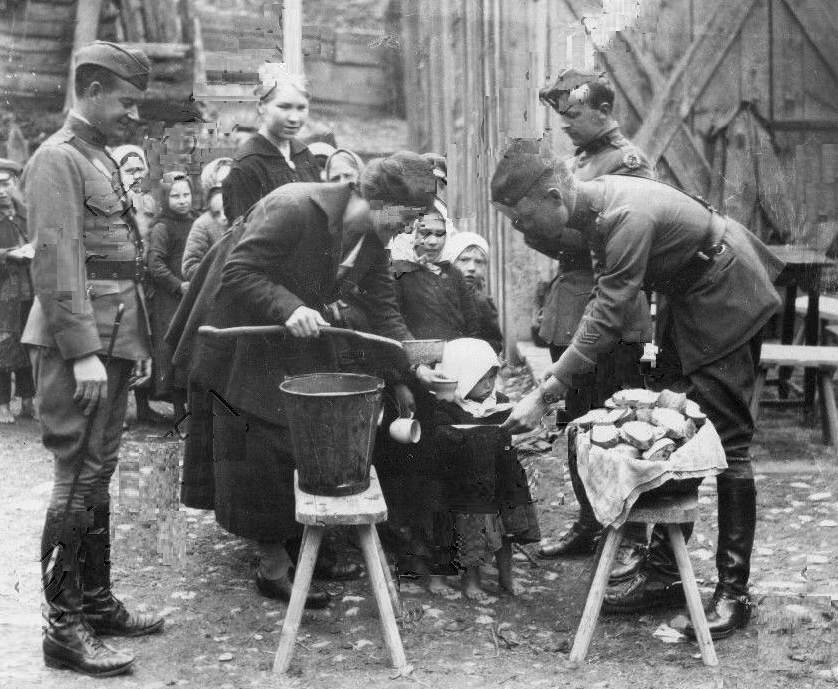
World War I Lithuania: American Relief

Figure 1.--Here we see American World War I relief workers feeding hungary children in Karno, Lithuania after World War I. We are not sure where that is, but the rudimentary building in the background suggests a small town. The ARA captions often got the names of small towns wrong as the ARA workers did not speak the local languages. The relief workers look like soldiers, but this is because both ARA and Red Cross workers wore U.S. Army uniforms. The children are receivg a hearty soup and bread. The caption provides only a basic description. "American Relief Committee Feeding Lithuanian Children: Members of the American Relief Committee feeding children in Karno, Lithunia. The Committee feeds thousands throughout Poland every day." The photograph is dated August 6, 1919. (Given how the children are dressed, this may be when the caption was written rather than when the phitograph was taken.) Notice the confusion with Lithuania and Poland. The ARA had a much larger feeding program in Poland and the border between Lithuania and Poland was not well established after World War I.
|
|
World War I resulted in a dramatic decline of food production throughout Europe. Conscription of agricultural workers, war damage, the unvailability of materils and products, and other factors created an increasing problem as the war progressed and reached crisis by 1918. This included Tsarist Russia and the areas in controlled in Eastern Europe. This area before the War was the breadbasket of Europe. Much of it like the Baltics including Lithuania was occupied by the Central Powers, primarily the Germans. The same factors were faced by the Allies, but control of the Sea meant that food could be shipped in from America. After the German capitulation and Armistice, America in an unprecedented act of humanitarianism began shipping food into Europe. Nothing like this had ever before occurred in all of world history. And only America's food shipments prevented mass starvation in Europe. The United Sttes provided the food briudge to sabe Europeans while gtheir their agricultural economies were revovering. his was a special problem in Lithunia as the fighting did not end in 1918 as in the West. The Lithuanians had to fight the Bolsheviks and ghe Poles. Lituania had a largely agricultural economy, but because of the War, people had begun to starve. We have not found much infomation on American feeding programs in the Baltics, including Lithunia. The Baltics like most of Poland had been part of the Tsarist Empire. We know there was extensive feeding progrms focusing on children. Of the three Baltic replublics, Lithuania was a little different because of its historic association with Poland. There was no clear boundary between Lithunia and Poland. In border areas the population was mixed. And much of Lithuania like Poland was within the Pale of Settlement. This meant that there was a substantial Jewish population. As a result the Joint provide relief support for Jews. No American Goverment relief effiorts were possible until after the Armistice (November 1918). We note the American Relief Committe feeding children (August 1919). This seems similar to the ARA operations in Poland. Even after the War there were complications, however, as the Bolsheviks tried to retake Poland and the Baltics. As far as we know there were no destributions in Bolshevik controlled areas. The Bolsheviks refued to allow it. Despite dire need, the Bolsheviks regarded the ARA as a hostile entity. We also notice Red Cross nurses operating in Lithuania, although we have few details. Nurses did not only work in hispitals, but were involved in relief work as well. Red Cross nurse Cora Elm serving in France had her passport validated for Lithusnia, Latvia, and Russia. We think the Russian validation was a optimisic assessment of the ability to get into Russia to assist the Russian people. We are not sure she used that passport because she married (1921). [Foxwell]
Sources
Foxwell, Elizabeth. "Relief workers, " American women in World War I (October 16, 2017).
CIH

Navigate the CIH World War I Section:
[Return to the main Main World War Lithuania page]
[Return to the main United States World War I American country relief efforts page]
[Return to the main Main World War I Tsarist Russian page]
[Return to the main Countries]
[Aftermath]
[Alliances]
[Animals]
[Armistace]
[Causes]
[Campaigns]
[Casualties]
[Children]
[Countries]
[Declaration of war]
[Deciding factors]
-------[Diplomacy]
[Economics]
-------[Geo-political crisis]
[Home front]
[Intelligence]
[Military forces]
[Neutrality]
[Pacifism]
[People]
[Peace treaties]
[Propaganda]
[POWs]
[Russian Revolution]
[Signals and intelligence]
[Terrorism]
[Trench warfare]
------[Technology]
------[Weaponry]
[Bibliographies]
[Contributions]
[FAQs]
[Images]
[Links]
[Registration]
[Tools]
[Return to Main World War I page]
[Return to Main war essay page]
Created: 11:39 AM 6/6/2018
Last updated: 11:39 AM 6/6/2018



